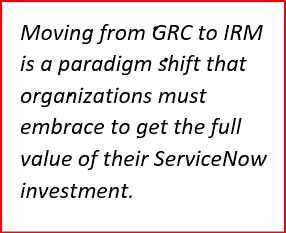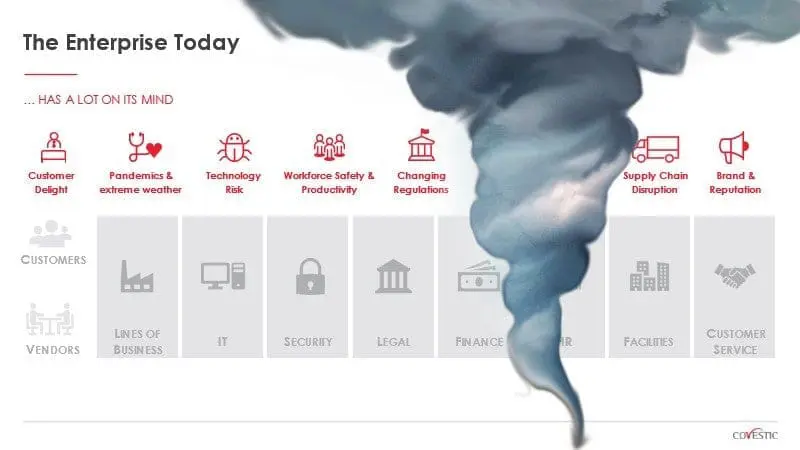The Great Paradigm Shift: Moving from ServiceNow GRC to IRM
Get the Full Value from Your ServiceNow Investment
What’s in a name? ServiceNow has no qualms about changing the names of its apps seemingly at each new release:
- IT Business Management? Now “Strategic Portfolio Management”
- Cloud Management -> “Cloud Provisioning and Governance”
- And Governance, Risk, and Compliance (GRC) now known as “Integrated Risk Management (IRM)”
To a casual user, a product name switcheroo appears purely cosmetic. For ServiceNow and its partners, moving from GRC to IRM symbolizes a paradigm shift that organizations need to embrace to get the full value of their investment in their ServiceNow solution.

Although ServiceNow GRC and ServiceNow IRM are both solutions for managing risk, the way you approach each one differs widely. Take, for instance, that as the number of cyber-attacks continues to threaten organizations, these organizations are not really meeting the attacks head-on. At least not yet. Most are just throwing new technologies at the problem, hoping to protect against attacks that have already happened.
Your phone is a great example of this mindset: The reason for the constant barrage of phone OS updates is not to protect against attacks that may yet come but ones that have already exploited vulnerabilities and hijacked thousands of phones like yours.
The Potential of ServiceNow GRC: The Cloud is Important, but It’s Not Everything
The promise of ServiceNow GRC stemmed from its cloud-based single-platform approach to assessing Governance, Risk Management, and Compliance. The single platform—unlike the previous approach of using disparate vendors to manage specific aspects of security—provided a real-time 360-degree view across compliance, risk, security, IT, and your organization as a whole. With the ServiceNow GRC approach, your customers could:
- Reach business objectives by ascertaining potential risk
- Integrate security tools and automate third-party risk management to improve visibility
- Improve customer support and interactions thanks to faster cloud-based innovation
- Quicken mitigation by automating security responses to IT teams
If There’s Anything the 2010s and 2020s Have Taught Us is to Expect the Unexpected
Pandemics, recessions, extreme weather events, and daily cybersecurity threats have demonstrated they can and will disrupt normal business operations.

As it turns out, organizations experienced great efficiencies after a ServiceNow GRC implementation. Such an operation reduced the:
- Burden of compliance on day-to-day operations
- Time/expense cost of audits
Result: Cost savings realized on corporate financials were a notable improvement to the bottom line.
But ServiceNow GRC’s Limitations Have Become Apparent
Risk and resilience data were siloed, leading to costly business disruptions and poor decision-making, causing many organizations to have some of their IT and risk management teams interconnected and many that were not—leading to high costs, poor decisions, and costly business disruptions. Siloing also leads to isolation enabling a ServiceNow GRC organization to manage risk reactively and causing compliance issues:
- Because the ServiceNow GRC team is responding to an incursion, they’re working to fix it and plugging the holes after an attack
- And because the ServiceNow GRC team is isolated when reacting to the attack, they’re unfortunately using manual and siloed work models and may feel they’re falling behind in the organization
How to Shift Your Focus from ServiceNow GRC to ServiceNow IRM
The first step in moving from ServiceNow GRC to IRM is to adjust how you think about risk assessment and security. In a GRC mindset, you:
- Focus on regulatory compliance
- Approach risk management in a conservative manner
- Operate risk management in a closed manner isolated from the rest of the organization
- Staff a separate GRC team outside the IT department
The ServiceNow GRC>IRM paradigm shift is simple: Flip the legacy GRC approach upside down. Traditionally, ServiceNow GRC solutions used spreadsheets to assess the compliance and risk posture of different aspects within the business, i.e., vendors, departments, systems, etc.

In a ServiceNow IRM team, its solutions embed themselves into the company’s organizational structure weaving throughout departments and influencing and managing risks. Because IRM is so integrated into a company’s goals, it is not so purely IT- or technology-focused but is business-oriented and aligns itself with business strategies.
This relatively simplistic way to tackle the shift from ServiceNow GRC to IRM pigeonholes an organization into a bottom-up architecture, where various aspects of the ServiceNow GRC>IRM paradigm shift are managed individually. This limits the ability to aggregate ServiceNow GRC-related data and increases the likelihood of duplicate controls and risks.
ServiceNow IRM, on the other hand, embraces a top-down approach. With our implementation of ServiceNow IRM, organizations operate from an unstructured organic approach to a more structured top-down methodology to leverage the use of data relationships and templates to generate control and risk libraries. With the ServiceNow IRM approach, a single control can be mapped to multiple external regulations and internal policies, reducing duplicates, and enabling organizations to “measure once, satisfy many.”
The templates in these libraries are then applied to the appropriate aspects of the business, generating a single instance of control or risk. This solution provides a level of granularity missing from legacy programs and streamlines GRC-related data aggregation, painting a more accurate picture of an organization’s compliance and risk posture.
Milestone’s ServiceNow IRM Prevents Attacks from Happening Now and Those in the Future
Without a 360-degree risk view, you’re exposing your organization to up-and-coming threats. So how do you protect your organization? How do you monitor and mitigate against something you have yet to see? Many organizations have already discovered that without a 360-degree risk assessment, it is virtually impossible to understand how organizations are meeting compliance and risk assessments.
To better address the needs of global organizations, Milestone has shifted focus away from ServiceNow GRC to ServiceNow IRM solutions because IRM is not a reactive solution, but one that provides actionable insights organizations use to counter future attacks. ServiceNow IRM solutions also provide a single point from which to act with a modern, cloud-based unified platform.
Incorporating Risk and Resilience into Your Business Processes
With ServiceNow IRM, Milestone gives you something unique: A cloud-based platform that shares data across your enterprise and is easier to implement, use, configure, and maintain than legacy GRC solutions. IRM has become an engine for ensuring risk and resilience and has incorporated those disciplines right into the business processes:
- With IRM, you can finally enable continuous compliance. Unlike your legacy GRC platform, IRM scales to detect changes in real time without impacting system performance
- Compared to legacy GRC platforms, ServiceNow has a lower cost of ownership and is easier to configure
- As the industry transitions from GRC to IRM, you need a truly integrated system that leverages a common Configuration Management Database (CMDB) to enable data sharing across the entire enterprise
How Milestone Implements ServiceNow IRM to Drive the “Great Paradigm Shift”
Whether you’re managing risk and compliance through manual processes or a sophisticated point solution today, there’s a compelling case for moving to Integrated Risk Management in ServiceNow.
With Milestone and ServiceNow IRM, organizations:
- Beat out legacy point solutions (like Archer)
- Save companies time and money through automated compliance testing
- Enable resolution of issues before they become audit findings
- Increase operational efficiency and reduce noise
- Provide unparalleled visibility and access to compliance processes and data across the enterprise
For more information on how Milestone’s ServiceNow IRM solution can help you, watch our webinar “Why GRC Leaders Are Moving to Integrated Risk Management in ServiceNow.”






